1. Introduction to the Recipe
There’s something uniquely comforting and elegant about pork chops with apple pan sauce, a dish that marries savory richness with subtle sweetness in a way that feels both timeless and refined. Pork and apples have long been a beloved pairing in classic European cooking, and for good reason—the gentle sweetness of apples amplifies the natural savoriness of pork without overpowering it. This recipe highlights that harmony in its purest form, using seared pork chops, lightly caramelized apples, and a vibrant cider pan sauce enriched with mustard, crème fraîche, and fresh thyme. The result? A gourmet meal that’s astonishingly easy to prepare at home, whether you’re cooking for a weeknight treat or an elevated dinner with guests.
Understanding the techniques behind a perfect pan sauce can significantly enhance your confidence in the kitchen. A resource like this guide on pan sauces can deepen your knowledge: https://www.seriouseats.com/how-to-make-pan-sauce. Likewise, if you’re curious about selecting the best apples for cooking, this helpful overview explains which varieties hold up best under heat: https://www.thekitchn.com/best-apples-for-cooking-229321. Exploring these details can increase your comfort level and help you achieve a polished, restaurant-quality dish.
What makes this recipe truly delightful is its balance. The caramelized butter-kissed apples bring a juicy brightness to each bite of tender pork, while the hard apple cider enriches the sauce with depth and tang. Fresh thyme adds aromatic warmth, and a spoonful of crème fraîche brings creaminess that ties the sauce together beautifully. Even though the dish sounds impressive—and tastes even better—it comes together quickly, using only one skillet, making cleanup minimal. In this full-length guide, you’ll find step-by-step instructions, advanced cooking techniques, storage and reheating tips, dietary adaptations, FAQs, and final reflections. Everything is curated to help you master this dish from start to finish.
2. Basic Recipe: Ingredients and Instructions
Print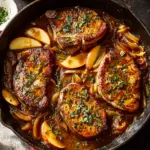
Pork Chops with Apple Pan Sauce Recipe
Description
This pork chops with apple pan sauce recipe creates a gourmet, flavorful meal with tender pork and a rich cider-infused sauce.
Ingredients
For the Apples
- 1 large apple, peeled, cored, and cut into 12 wedges
- 1 tablespoon butter
For the Pork Chops
- 2 pork chops, bone-in, 3/4–1 inch thick
- Salt and freshly ground pepper
- 2 tablespoons flour
- 1 tablespoon butter
For the Cider Pan Sauce
- 1/4 cup hard apple cider (see notes)
- 1/2 cup chicken broth
- 1/2 teaspoon Dijon mustard
- 1 tablespoon crème fraîche or heavy cream
- 1/4–1/2 teaspoon fresh thyme leaves (or pinch dried thyme)
- Salt and freshly ground pepper
- 1–2 tablespoons additional hard apple cider
Instructions
- Cook the apples: Melt 1 tablespoon butter in a skillet over medium heat. Add apple wedges and cook until lightly caramelized, 4–6 minutes. Transfer to a plate.
- Prepare the pork chops: Pat dry, season generously with salt and pepper, and dredge lightly in flour.
- Sear the pork: Add 1 tablespoon butter to the skillet. Sear chops 3–4 minutes per side until golden and just cooked through. Transfer to a plate and tent with foil.
- Start the pan sauce: Add 1/4 cup hard cider to the skillet, scraping browned bits.
- Add broth and seasonings: Stir in chicken broth, Dijon mustard, thyme, salt, and pepper. Simmer 3–4 minutes until reduced.
- Finish the sauce: Reduce heat and whisk in crème fraîche or cream, plus 1–2 tablespoons more cider if desired.
- Return apples and pork: Add apples back to the skillet and spoon sauce over the pork chops.
- Serve immediately with extra pan sauce drizzled on top.
Notes
Hard cider adds complexity, but non-alcoholic apple cider may be substituted.
Bone-in pork chops retain moisture better than boneless.
If sauce is too tangy, a teaspoon of honey balances flavors beautifully.
3. Advanced Techniques
Perfecting the Sear for Golden, Juicy Pork Chops
Achieving a good sear is key to flavorful pork chops with apple pan sauce. Start by thoroughly drying the chops so they brown properly. Use a heavy skillet—cast iron is ideal—heated until the butter just begins to foam. Avoid overcrowding the pan, as this traps steam and prevents browning. Let the chops cook undisturbed for several minutes so a golden crust can form. A proper sear adds both textural contrast and depth to the flavor of the overall dish. It also provides the delicious browned bits (fond) needed to build a rich, silky pan sauce.
Building a Balanced Pan Sauce with Deglazing
Deglazing is the heart of any great pan sauce. When you add cider to the hot skillet, be sure to scrape every bit of fond—these caramelized fragments infuse the sauce with complexity. Understanding reduction is equally important. Allow the cider and broth to simmer until the sauce thickens enough to coat the back of a spoon. Too thin, and the sauce will feel watery; too thick, and the flavors may concentrate too much. Monitoring this stage closely ensures a perfectly balanced sauce that complements, rather than overwhelms, the pork.
Using Flour to Improve Texture and Browning
Lightly dusting the pork chops in flour has multiple benefits. First, the flour helps create a delicate crust that enhances browning and adds a subtle crunch. Second, the flour residue left in the pan helps slightly thicken the sauce, giving it body without requiring additional thickeners. This technique works best when used sparingly—a light coating is enough. While optional, it’s a classic professional trick that produces more consistent results, especially when paired with caramelized apples and a cider-based sauce.
Elevating Flavor with Layered Apple Notes
One advanced way to elevate this recipe is by layering different apple elements. Use both cooked apple wedges and a splash of cider for bright acidity. You can take it further by adding a tablespoon of apple butter for a silky, concentrated sweetness that deepens the overall flavor profile. Different apple varieties also change the final result—Honeycrisp offers sweetness, Granny Smith gives tart vibrancy, and Pink Lady adds floral notes. Combining varieties delivers even greater complexity, making each bite varied and interesting.
Fine-Tuning the Final Sauce Texture
Professional chefs control sauce texture with precision, and you can too. After adding crème fraîche or heavy cream, adjust the consistency by simmering briefly to thicken or adding broth to thin. Keep heat moderate to prevent curdling. If you want a smoother texture, strain the sauce through a fine mesh sieve before returning it to the pan with the apples. For extra gloss, whisk in one teaspoon of cold butter at the end—this classic finishing technique, called monter au beurre, produces a silky, restaurant-quality sauce.
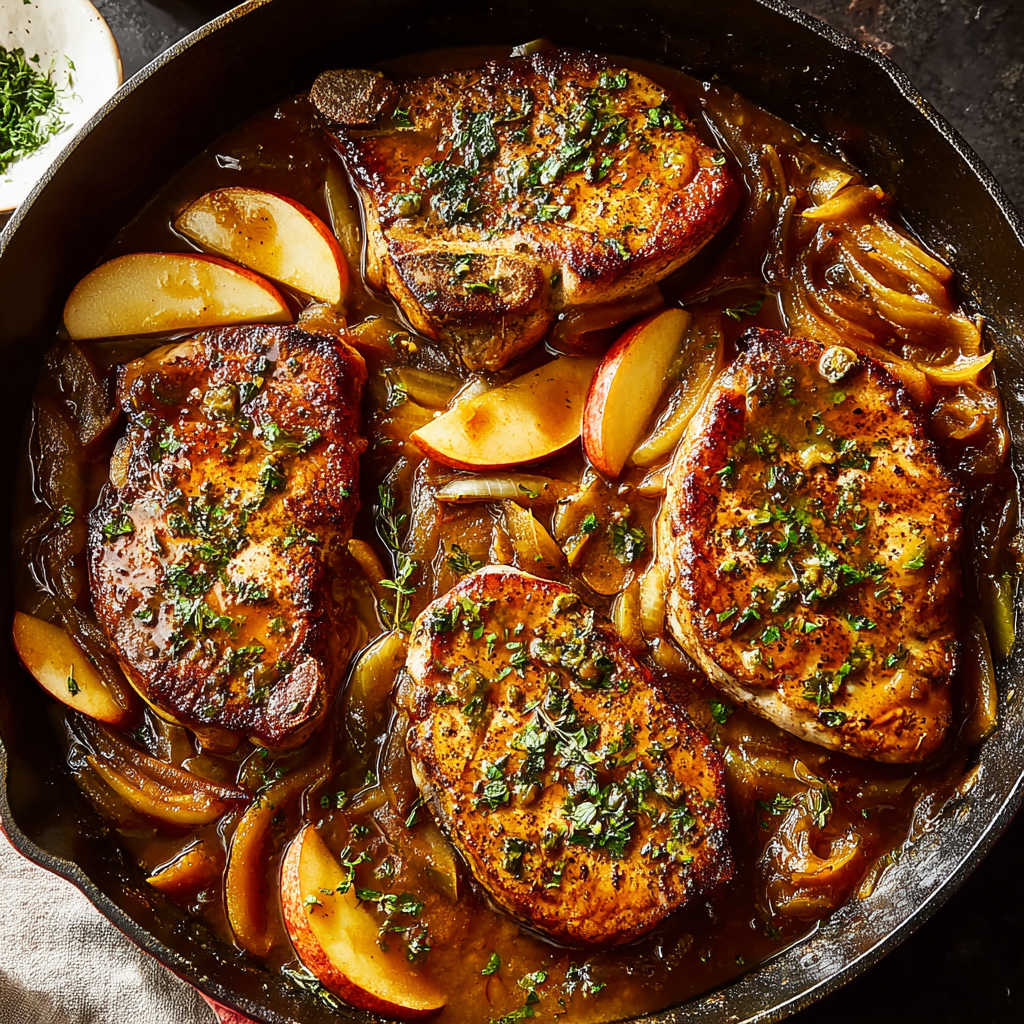
4. Storage, Shelf Life, and Maintenance Tips
Refrigerating Leftover Pork Chops Safely
Leftovers store well for up to 3–4 days when placed in airtight containers. Keep pork chops separate from the apples and sauce if possible to preserve texture. Store sauce in a small jar and reheat gently to prevent separation. Refrigerated properly, the dish retains its flavor but reheating carefully is essential for maintaining tenderness.
Freezing Leftovers Without Losing Quality
To freeze, wrap cooled pork chops individually in plastic wrap, then store them in a freezer-safe bag for up to 2–3 months. Keep the sauce in a separate freezer-safe container. Thaw overnight in the refrigerator before reheating. To restore moisture, add a splash of broth while warming. Apples may soften after freezing, but their flavor remains delicious.
Maintaining Sauce Flavor After Storage
Pan sauces can separate after refrigeration, but gentle reheating solves this. Warm the sauce on low heat, whisking occasionally. If the sauce becomes too thick, add a tablespoon of broth or cider. Avoid boiling, as high heat may cause crème fraîche or cream to split. If separation occurs, whisking in a small pad of cold butter can bring it back together.
Reheating Pork Chops Without Drying Them Out
Reheating pork requires a gentle approach. Preheat your oven to 300°F (150°C) and cover the pork chops in foil with a spoonful of sauce or broth. Heat for 10–12 minutes until just warm. Microwaving is possible but risky; if used, reheat at 50% power in 20-second increments. The goal is to warm the pork without cooking it further.
Storing Apples for Best Texture
Caramelized apples stored on their own maintain their texture better than apples stored in sauce. Place them in an airtight container lined with parchment or paper towel to absorb excess moisture. Reheat in a skillet for 1–2 minutes to revive their caramelized edges. Avoid microwaving apples, as this leads to mushiness.
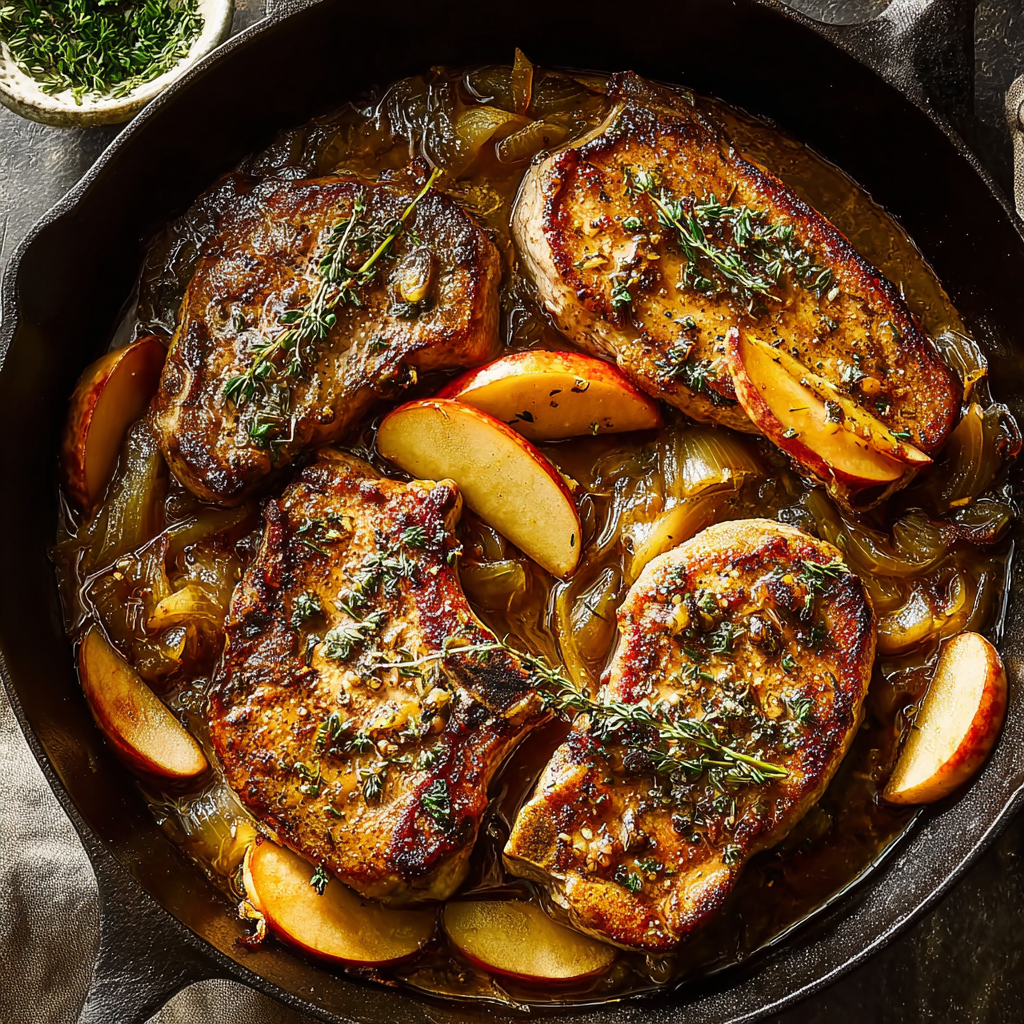
5. Dietary Adaptations and Substitutions
Gluten-Free Adaptation
To make pork chops with apple pan sauce gluten-free, simply omit the flour or use a certified gluten-free flour blend. The sauce thickens naturally through reduction, so flour is not essential. Check mustard labels for gluten and use gluten-free broth. The hard cider is typically gluten-free, but always verify brand labels for safety.
Low-Carb or Keto-Friendly Version
Eliminate the flour dredge and replace the cider with apple-flavored sparkling water or diluted apple extract. Use heavy cream instead of crème fraîche for a richer, keto-friendly sauce. Substitute apples with sautéed zucchini or turnips to maintain sweetness without extra carbohydrates.
Dairy-Free Adaptation
Replace butter with olive oil or plant-based butter. Substitute crème fraîche with coconut cream or a dairy-free yogurt alternative. The sauce will remain creamy but with a slightly different richness. Ensure Dijon mustard is dairy-free. This adaptation maintains the dish’s essence while accommodating dietary needs.
Low-Sodium Variation
Use unsalted butter, low-sodium broth, and reduced-sodium mustard. Hard cider typically contains little sodium, making it safe to include. Enhance flavor with extra thyme, garlic, and pepper. Avoid salting the pork until after tasting the finished sauce.
Alcohol-Free Version
Replace hard cider with regular apple cider or apple juice. Add a teaspoon of white wine vinegar for brightness. The sauce will be sweeter, so adjust seasoning accordingly. This version is ideal for families or anyone avoiding alcohol.
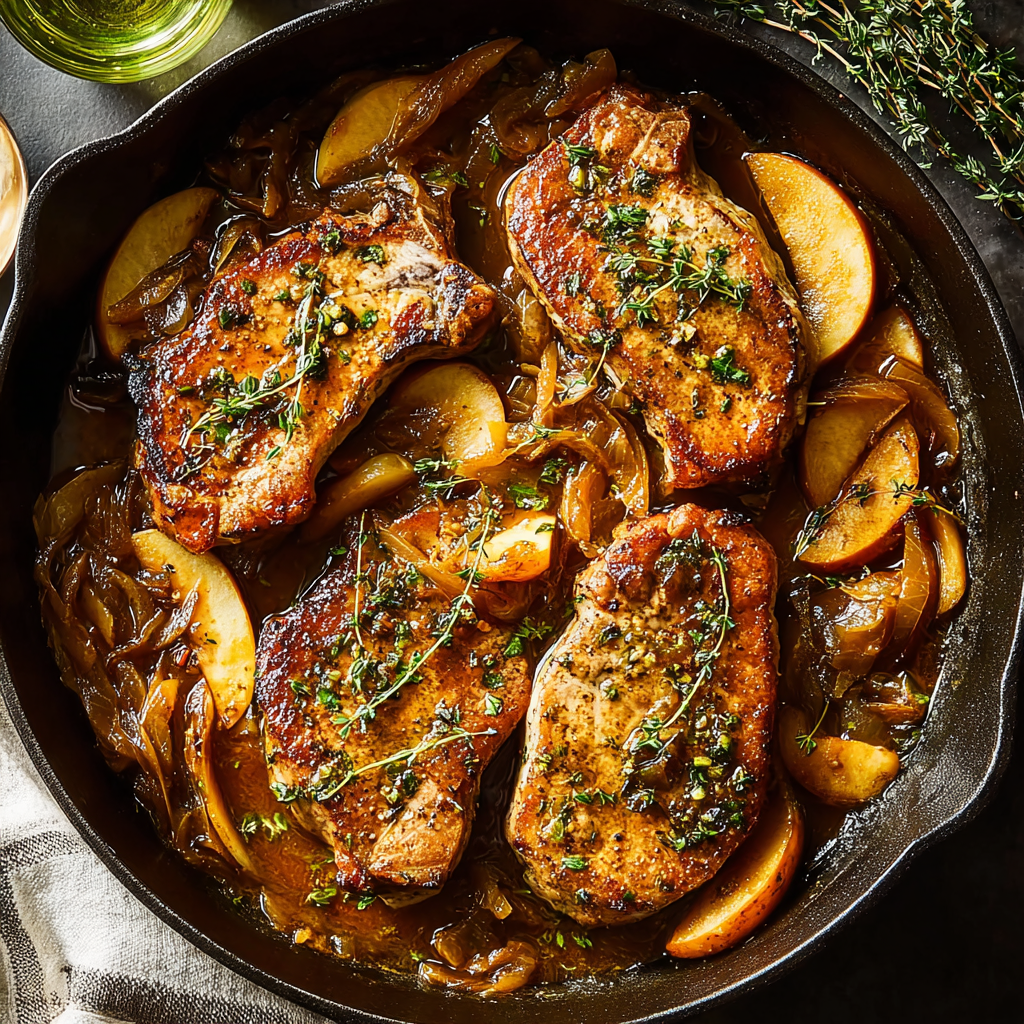
6. FAQs About the Recipe
Why Are My Pork Chops Tough?
Toughness usually comes from overcooking. Pork chops are lean and should be cooked to 145°F (63°C) for maximum tenderness. Letting them rest after cooking helps juices redistribute. Using bone-in chops also reduces the risk of dryness. Searing too long or on overly high heat can toughen the meat as well.
Can I Use Boneless Pork Chops?
Yes, but boneless chops cook faster and may require reduced cooking time. Because they are leaner and thinner, monitor closely to avoid dryness. Boneless chops also produce less fond, so the pan sauce may be slightly lighter. Bone-in chops are recommended for best flavor and moisture retention.
Can I Substitute the Apple Variety?
Absolutely. Choose firm apples that hold their shape during cooking—Honeycrisp, Granny Smith, Pink Lady, or Braeburn are ideal. Softer apples like Gala may break down more quickly. Different apple varieties bring different levels of sweetness and tartness, allowing you to customize the dish.
Can I Double the Sauce?
Yes. Simply double all sauce ingredients and increase reduction time slightly. Be sure not to overcrowd the pan with pork chops; otherwise, the sauce will steam instead of thickening. Doubling the sauce is especially useful if serving over mashed potatoes, noodles, or rice.
Why Did My Sauce Separate?
Sauce separation occurs when heat is too high after adding cream. To prevent this, lower the heat before incorporating crème fraîche or heavy cream. If separation happens, whisk vigorously or add a teaspoon of cold butter to help emulsify the sauce. Avoid boiling creamy sauces.
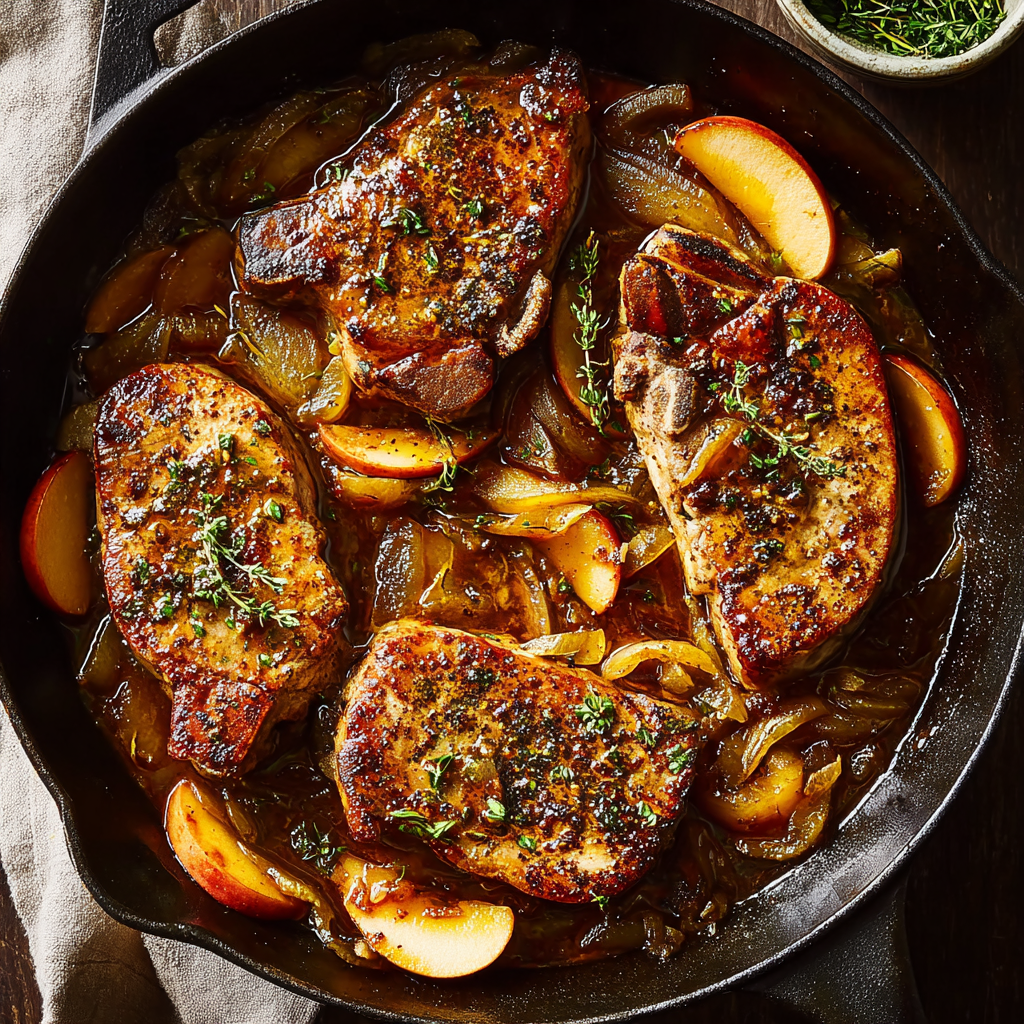
7. Conclusion & Final Thoughts
This pork chops with apple pan sauce recipe embodies everything wonderful about cozy, sophisticated home cooking. The sweetness of caramelized apples, richness of the cider pan sauce, and savoriness of well-seared pork create a dish that feels both comforting and gourmet. Whether you are cooking for your family, planning a romantic dinner, or simply craving something warm and satisfying, this recipe delivers impressive results with minimal effort and ingredients.
One of the greatest strengths of this dish is its versatility. It adapts beautifully to different diets, seasons, and personal tastes. Whether you choose bone-in or boneless chops, tart or sweet apples, cider or broth variations, the core flavors remain balanced and delicious. The one-pan method keeps cleanup simple, while the advanced tips help you refine your technique and elevate the sauce to restaurant-quality finesse.
From the moment the apples begin to caramelize to the final drizzle of silky cider sauce over tender pork, this meal transforms everyday ingredients into something truly memorable. Its ability to bring warmth, aroma, and a touch of elegance to the dinner table is what makes this recipe timeless. Once you master these steps, pork chops with apple pan sauce may very well become a signature dish in your home—one you’ll return to again and again for its dependable flavor, comforting simplicity, and unmistakable charm.
